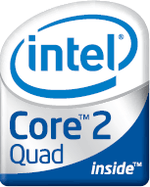Intel Core 2
 | |
| Produced | From 2006 to 2011 |
|---|---|
| Common manufacturer(s) |
|
| Max. CPU clock rate | 1.06 GHz to 3.33 GHz |
| FSB speeds | 800 MT/s to 1600 MT/s |
| Min. feature size | 65 nm to 45 nm |
| Instruction set | x86, x86-64, (SSE4.1 is for 45 nm processors only) |
| Microarchitecture | Core |
| Cores | 1, 2, or 4 (2x2) |
| Socket(s) |
|
| Predecessor | Pentium D, Intel Core, Pentium 4 |
| Successor | Core i3, i5, i7, i9 |
| Core name(s) |
|
Core 2 is a brand encompassing a range of Intel's consumer 64-bit x86-64 single-, dual-, and quad-core microprocessors based on the Core microarchitecture. The single- and dual-core models are single-die, whereas the quad-core models comprise two dies, each containing two cores, packaged in a multi-chip module.[1] The introduction of Core 2 relegated the Pentium brand to the mid-range market, and reunified laptop and desktop CPU lines for marketing purposes under the same product name, which previously had been divided into the Pentium 4, Pentium D, and Pentium M brands.
The Core 2 brand was introduced on 27 July 2006,[2] comprising the Solo (single-core), Duo (dual-core), Quad (quad-core), and in 2007, the Extreme (dual- or quad-core CPUs for enthusiasts) subbrands.[3] Intel Core 2 processors with vPro technology (designed for businesses) include the dual-core and quad-core branches.[4]
Models
The Core 2-branded CPUs include: "Conroe"/"Allendale" (dual-core for desktops), "Merom" (dual-core for laptops), "Merom-L" (single-core for laptops), "Kentsfield" (quad-core for desktops), and the updated variants named "Wolfdale" (dual-core for desktops), "Penryn" (dual-core for laptops), and "Yorkfield" (quad-core for desktops). (Note: For the server and workstation "Woodcrest", "Tigerton", "Harpertown" and "Dunnington" CPUs see the Xeon brand.[5])
The Core 2 branded processors feature Virtualization Technology (with some exceptions), Execute Disable Bit, and SSE3. Their Core microarchitecture introduced SSSE3, Trusted Execution Technology, Enhanced SpeedStep, and Active Management Technology (iAMT2). With a maximum thermal design power (TDP) of 65W, the Core 2 Duo Conroe dissipates half the power of the less capable contemporary Pentium D-branded desktop chips[6] that have a max TDP of 130W.[7]
| Intel Core 2 processor family | |||||||
|---|---|---|---|---|---|---|---|
| Original logo |
2009 new logo |
Desktop | Laptop | ||||
| Code-name | Core | Date released | Code-name | Core | Date released | ||
 |
 |
Conroe Allendale Wolfdale |
dual (65 nm) dual (65 nm) dual (45 nm) |
August 2006 January 2007 January 2008 |
Merom Penryn |
dual (65 nm) dual (45 nm) |
July 2006 January 2008 |
 |
 |
Conroe XE Kentsfield XE Yorkfield XE |
dual (65 nm) quad (65 nm) quad (45 nm) |
July 2006 November 2006 November 2007 |
Merom XE Penryn XE Penryn XE |
dual (65 nm) dual (45 nm) quad (45 nm) |
July 2007 January 2008 August 2008 |
 |
 |
Kentsfield Yorkfield |
quad (65 nm) quad (45 nm) |
January 2007 March 2008 |
Penryn | quad (45 nm) | August 2008 |
 |
 |
Merom-L Penryn-L |
Single (65 nm) Single (45 nm) |
September 2007 May 2008 | |||
| List of Intel Core 2 microprocessors | |||||||
With the release of the Core 2 processor, the abbreviation C2 has come into common use, with its variants C2D (the present Core 2 Duo), and C2Q, C2E to refer to the Core 2 Quad and Core 2 Extreme processors respectively. C2QX stands for the Extreme-Editions of the Quad (QX6700, QX6800, QX6850).
The successors to the Core 2 brand are a set of Nehalem microarchitecture based processors called Core i3, i5, and i7. Core i7 was officially launched on 17 November 2008 as a family of three quad-core processor desktop models, further models started appearing throughout 2009. The last Core 2 processor to be released was the Core 2 Quad Q9500 in January 2010. The Core 2 processor line was removed from the official price lists in July 2011.[8][9]
See also
References
- ↑ "Intel Clovertowns step up, reduce power". TG Daily. Retrieved 5 September 2007.
- ↑ "Intel Unveils World's Best Processor". Intel. Archived from the original on 3 April 2007. Retrieved 14 August 2007.
- ↑ "Intel to unify product naming scheme". TG Daily. Retrieved 6 August 2007.
- ↑ "Intel Centrino 2 with vPro technology and Intel Core2 processor with vPro technology" (PDF). Intel. Retrieved 7 August 2008.
- ↑ "Intel Unleashes New Server Processors That Deliver World-Class Performance And Power Efficiency". Intel. Archived from the original on 1 July 2006. Retrieved 26 June 2006.
- ↑ "The 65 nm Pentium D 900's Coming Out Party: Test Setup". Tom's Hardware. Retrieved 15 June 2007.
- ↑ "The 65 nm Pentium D 900's Coming Out Party: Thermal Design Power Overview". Tom's Hardware. Retrieved 15 June 2007.
- ↑ "Intel Processor Pricing, Effective July 10, 2011" (PDF). Intel Corp. Retrieved 17 July 2011.
- ↑ "Intel Processor Pricing, Effective July 17, 2011" (PDF). Intel Corp. Retrieved 17 July 2011.
External links
1st public demonstration:Anandtech discovers Core 2 Duo performance under the supervision of Francois Piednoel
- Intel Penryn Architecture and Performance Preview
- Intel Centrino Duo Mobile Technology papers
- Intel Core Microarchitecture
- Intel's Core 2 page at the Wayback Machine (archived 14 July 2006)